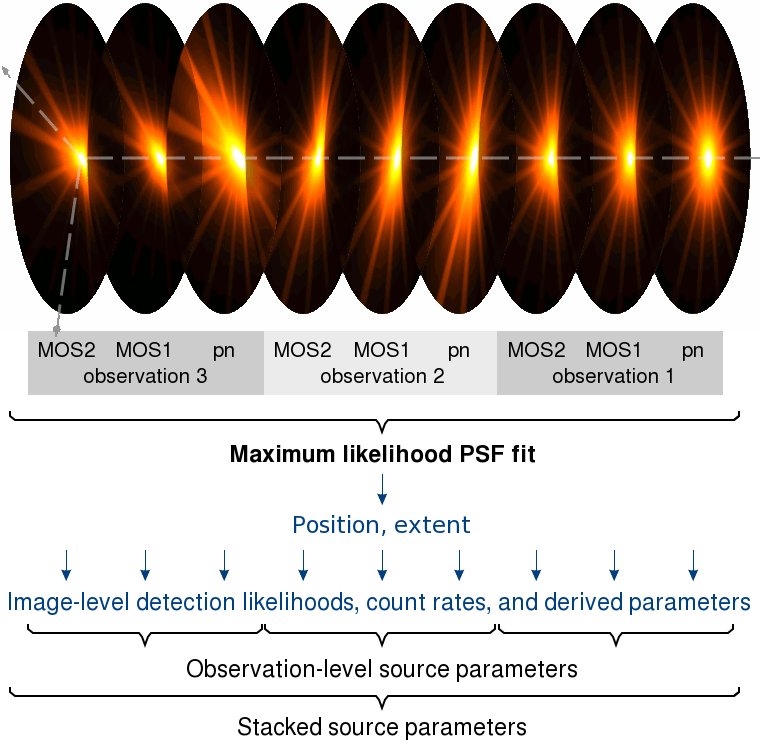Data processing
The source catalogue from overlapping observations is based on archival XMM-Newton attitude files and event lists which were processed with tasks of the XMM-Newton Science Analysis Software by the SOC pipeline. For the stacked catalogue, the data handling has been adjusted to the needs of source detection on multiple observations, using the same parameters as in the 4XMM pipeline wherever applicable. The new standardised approach to perform stacked source detection on multiple observations is available as SAS task edetect_stack. Input data to source detection are prepared for each observation individually, and source detection is run on all input data in parallel, namely: images, exposure maps, background maps, and detection masks. The final source parameters are calculated by edetect_stack.
Standard source detection
This paragraph summarises information originally provided by the Astronomy Group at the University of Leicester for the 2XMM and 3XMM editions of the Serendipitous Source Catalogues from individual pointings. Additionally, details on recent catalogue releases in the 4XMM series and key change with respect to earlier releases are available from the 4XMM-DR11 documentation and links therein.
During the pipeline processing of all XMM-Newton data, cleaned event lists are created: * Good time intervals are identified and marked. * Bad CCD pixels are identified and masked. * Raw CCD coordinates are converted to celestial coordinates using the attitude information. * Raw event pulse heights are converted to event energies. * Good events are selected with the XMMEA_EP flag for EPIC/pn and XMMEA_EM flag for EPIC/MOS. * Per-CCD event lists are merged. * Intervals of flaring background are identified and marked.
From these filtered event lists, images in the five XMM-Newton standard energy bands are extracted, where band 1 corresponds to 0.2–0.5 keV, band 2 to 0.5–1.0 keV, band 3 to 1.0–2.0 keV, band 4 to 2.0–4.5 keV, and band 5 to 4.5–12.0 keV: * Flare intervals of at least 100 s duration are rejected. * Good events in the field of view are selected for EPIC/pn applying PATTERN≤4 (PATTERN==0 for band 1) and RAWY>12, for EPIC/MOS applying PATTERN≤12.
Images are binned to 600 by 600 square pixels having a pixel side of 4". Exposure maps, background maps, and detector masks are created in the same binning. Exposure maps are produced by the task eexpmap, taking into account the mirror vignetting, quantum efficiency, filter transmission, CCD gaps and bad columns and pixels. Detection masks are produced by the task emask for each instrument, including all areas where the exposure is at least half the maximum exposure. To model the background emission, tentative sources are identified by the task eboxdetect in so-called local mode, using a sliding box cell detection to search for excesses above the local background. Areas about the tentative source positions are masked in the image, and the background is modeled by the task esplinemap in its adaptive smoothing mode.
Source detection consists of a two-stage process: First, tentative source positions are identified now taking the background model into account, using the task eboxdetect in so-called map mode. Sources with a Poisson detection likelihood of at least five are included in the source lists, which serves as input to the second stage: maximum-likelihood PSF fitting by the task emldetect. emldetect calculates the source parameters by fitting the local point-spread function, convolved with a beta extent model if applicable, to the count distributions in all images simultaneously. Extent model and fitting are described in SSC-AIP-TN-003.pdf. Free parameters of the fit are a common source position, a common source extent, and individual count rates in each image. Detection likelihoods are derived and used to select sources with a likelihood of at least six. Extent likelihoods are dereived and used together with the extent radius to classify sources as either point-like or extended. In a separate step, a fit with two PSFs to extended sources is tested with respect to a single-PSF fit, which can be insufficient to describe the brightness distribution of extended sources. If the two-PSF fit improves the detection likelihood, the source parameters are re-calculated from it. A full list of all source parameters derived by emldetect can be found in the task documentation and in the list of 4XMM catalogue columns.
 Sketch of a fit to the different PSF shapes in the three EPIC instruments at different off-axis and azimuth angles in overlapping observations. Position and extent of a source are the same in all oabservations, while the count rates are fit in each image. Observation-level and stacked parameters are derived from the same fit, using the parameters of the individual contributing images.
Sketch of a fit to the different PSF shapes in the three EPIC instruments at different off-axis and azimuth angles in overlapping observations. Position and extent of a source are the same in all oabservations, while the count rates are fit in each image. Observation-level and stacked parameters are derived from the same fit, using the parameters of the individual contributing images.
Stacked source detection
All data products are used in parallel by the source-detection tasks, coupling images, exposure maps, and background maps for each observation, instrument, and energy band, and detection masks for each observation and instrument. Simultaneous source detection is performed by means of the usual two-step process used for XMM-Newton data: sliding-box source detection followed by maximum-likelihood fitting. Deviating from standard source detection
-
eboxdetect is run on each input observation separately and on mosaicked images of all contributing observations, combined per EPIC instrument and energy band by the task imweightadd. The resulting eboxdetect source lists are merged by the task srcmatch within a fixed matching radius of the pixel size times square root of two (i.e. ∼11.3″ for the catalogue). The likelihood column of the merged source list holds the maximum detection likelihood of a source from all contributing lists.
-
emldetect is called by edetect_stack with a minimum detection likelihood of zero in order to store the parameters of each box-detection source and each input image in an intermediate source list without (de)selecting sources based on to their detection likelihood.
Source parameters are derived from the simultaneous fit to all input data. The count rate is fit in each input image, while source position and extent are the same in all images. All-stack source parameters are calculated from all image-level values. Observation-level source parameters are calculated from the same fit by selecting the values from those images that were taken during the respective observation only (see sketch). A separate module of the task edetect_stack is dedicated to the calculation of the final source parameters, the quality assessment, and source filtering. In particular, the total equivalent likelihood over all observations and the likelihood for each individual observation are calculated for each detection and used for source selection. Sources are included in the final source list if at least one of these equivalent likelihoods exceeds a user-defined minimum detection likelihood. As for the other Serendipitous Source Catalogues, a minimum likelihood of six is required for inclusion in the catalogue.
Background modeling
The EPIC background includes an internal instrumental background and external components such as the cosmic X-ray background together with a time-variable local particle background linked to the complex interaction of solar activity with the Earth's magnetosphere. For source detection, time intervals dominated by variable background are filtered from the event lists. The remaining background is modelled based on source-free (“cheesed”) images by the task esplinemap and subtracted from the original images within the source-detection tasks. To construct the cheesed image, circular regions are excluded at the position of each tentative source, based on a brightness cut at 2×10–4 cts arcsec–2 s. For the stacked catalogue, an adaptive smoothing method has been employed to model the background emission. The cheesed images and corresponding masks are convolved with a Gaussian kernel with an initial smoothing radius of 10 pixels, and the signal-to-noise ratio of the smoothed image is calculated at each pixel. In eight steps, the radius of the Gaussian kernel is increased by a factor of square root of two. For each image pixel, the two smoothed images with the signal-to-noise ratios closest to a pre-defined threshold of 12 are selected, opting for a uniform signal-to-noise ratio over the whole image, which limits the allowed noise fluctuations. The background value of the pixel is linearly interpolated between them. Small-scale structures are thus covered by the images with the narrowest smoothing radii, while the cut-out regions around the sources are filled by values from the images smoothed with a broad Gaussian kernel.

